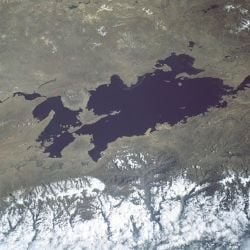Difference between revisions of "Template: Popular article 02 23" - New World Encyclopedia
From New World Encyclopedia
| Line 1: | Line 1: | ||
{{Main page article box| | {{Main page article box| | ||
type=Popular| | type=Popular| | ||
| − | title= | + | title=Lake Titicaca| |
| − | image_name= | + | image_name=Lake titicaca.jpg| |
| − | image_desc= | + | image_desc=Lake Titicaca from space, May 1985| |
| − | text= | + | text='''Lake Titicaca''' is the highest commercially navigable [[lake]] in the world, at 12,507 feet (3,812 m) above sea level, and the largest freshwater lake in [[South America]]. Located in the Altiplano (high plains) in the [[Andes]] on the border of [[Peru]] and [[Bolivia]], the western part of the lake belongs to the Puno Region of Peru, and the eastern side is located in the Bolivian La Paz Department. The Bolivian naval force uses the lake to carry out exercises, maintaining an active navy despite being landlocked. |
}} | }} | ||
Latest revision as of 23:09, 3 May 2023
Popular Article: Lake Titicaca
Lake Titicaca is the highest commercially navigable lake in the world, at 12,507 feet (3,812 m) above sea level, and the largest freshwater lake in South America. Located in the Altiplano (high plains) in the Andes on the border of Peru and Bolivia, the western part of the lake belongs to the Puno Region of Peru, and the eastern side is located in the Bolivian La Paz Department. The Bolivian naval force uses the lake to carry out exercises, maintaining an active navy despite being landlocked.
